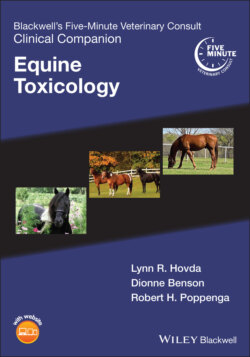Читать книгу Blackwell's Five-Minute Veterinary Consult Clinical Companion - Группа авторов - Страница 65
ОглавлениеChapter 8 Dermorphin
DEFINITION/OVERVIEW
Dermorphin (“derm” = skin, and “morphin” = morphine) is just one compound in a family of peptides secreted by the skin of South American hylid frogs, genus Phyllomedusa.
Most commonly found as a synthesized series of amino acids.
Dermorphin is a hepta‐peptide known to have exceptionally long‐lasting and potent opioid activity.
Potency is about 30–40 times greater than that of morphine, and less likely to cause a drug tolerance effect and addiction in humans.
In humans it has been shown to block pain effectively.
First detected in post‐race testing in Quarter Horse racing in the southwestern United States in 30 horses in 2011–2012.
Dermorphin stimulates locomotor activity and purportedly improves focus and determination in equines.
The D‐isomer is biologically active, but the L‐isomer is not.
Prohibited under ARCI and AQHA rules.
ETIOLOGY/PATHOPHYSIOLOGY
Mechanism of Action
Dermorphin is a mu‐opioid receptor‐binding peptide that causes central and peripheral effects after intravenous administration to rats, dogs, and humans.
In addition to dermorphin, the family of mu‐opioid agonists include seven naturally occurring dermorphin analogs, and at least 30 known synthetic analogs. The inactive L‐isomer of dermorphin is also known as “pseudomorphin”. Another close relative is HYP6‐dermorphin, which contains hydroxyproline instead of proline in the otherwise same amino acid sequence.
Some members of the dermorphin peptide family can cross the blood–brain barrier (BBB) and produce central antinociception after peripheral administration, but dermorphin itself is not able to cross the BBB.
Toxicokinetics
Onset of action is rapid with clinical signs appearing in minutes.
Duration of action is short, with most clinical signs subsiding within hours.
Hepatic and renal metabolism was observed in rats.
Urinary excretion primarily.
Toxicity
Toxicity observed in horses in doses of 5 mg.
Compounded versions may have variable toxicity.
Dermorphin is unstable at room temp, with some studies showing > 50% degradation after 4 hours at room temperature which may contribute to toxicity. The L‐isomer (inactive stereoisomer) is more labile than the D‐isomer (active form).
Systems Affected
Neurological – head shaking, sedation, sweating, increased locomotion, catalepsy.
Gastrointestinal – colic, decreased borborygmi.
Cardiovascular – tachypnea.
Musculoskeletal – antinociception.
SIGNALMENT
Risk Factors
Iatrogenic.
Historical Findings
Owners and trainers may be reluctant to admit possession or use.
Location and Circumstances of Poisoning
Likely in competitive equine sports environment (e.g., racing, barrel racing, etc.).
CLINICAL FEATURES
Clinical signs begin less than a minute after administration.
Common signs include head shaking, sedation, sweating, trance‐like state, colic, tachypnea, and antinociception.
DIFFERENTIAL DIAGNOSIS
CNS depressants (benzodiazepine, opioids).
Hallucinogenic plants and mushrooms.
Ethanol.
Rabies.
Colic of other etiology.
DIAGNOSTICS
CBC/Serum Chemistry/Urinalysis
Routine bloodwork:Hyponatremia/hypokalemia reported in humans but may be attributable to other causes.
Presence in serum and urine:Detection times of 12 hours in plasma and approximately 48–72 hours in urine using LC‐MS detection which is useful for diagnosis.
Pathological Findings
None reported in horses.
Therapeutics
The goal of therapy is to provide supportive care.
Detoxification
None.
Appropriate Health Care
Field treatment.
Antidotes
None.
Drugs of Choice
None.
Precautions/Interactions
Protection for the head and limbs may be necessary due to headshaking, increased locomotion, and anti‐nociception.
COMMENTS
Client Education
LC‐MS/MS may be useful in legal cases.
Prevention/Avoidance
Education trainers and owners about potential issues.
Possible Complications
Musculoskeletal injury due to antinociception.
Sudden death reported in humans.
Expected Course and Prognosis
No reported fatal toxicosis in horses. Effects generally subside after 1 hour.
Abbreviations
See Appendix 1 for a complete list.
Suggested Reading
1 Melchiorri P, Negri L. The dermorphin peptide family. Gen Pharm 1996; 27(7):1099–1107.
2 Negri L, Espamer GF, Severini C, et al. Dermorphin‐related peptides from the skin of Phyllomedusa bicolor and their amidated analogs activate two μ opioid receptor subtypes that modulate antinociception and catalepsy in the rat. Proc Natl Acad Sci 1992; 89: 7203–7207.
3 Negri L, Improta G. Distribution and metabolism of dermorphin in rats. Pharmacol Res Commun 1984; 16(12):1183–1191.
4 Robinson MA, Guan F, McDonnell S., et al., Pharmacokinetics and pharmacodynamics of dermorphin in the horse. J Vet Pharmacol Ther 2015; 38(4):321–329.
Author: Petra Hartmann‐Fischbach, MS, FAORC
Consulting Editor: Dionne Benson, DVM, JD
